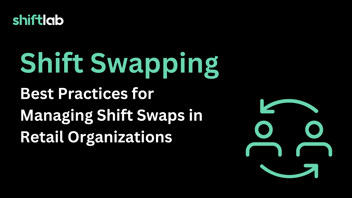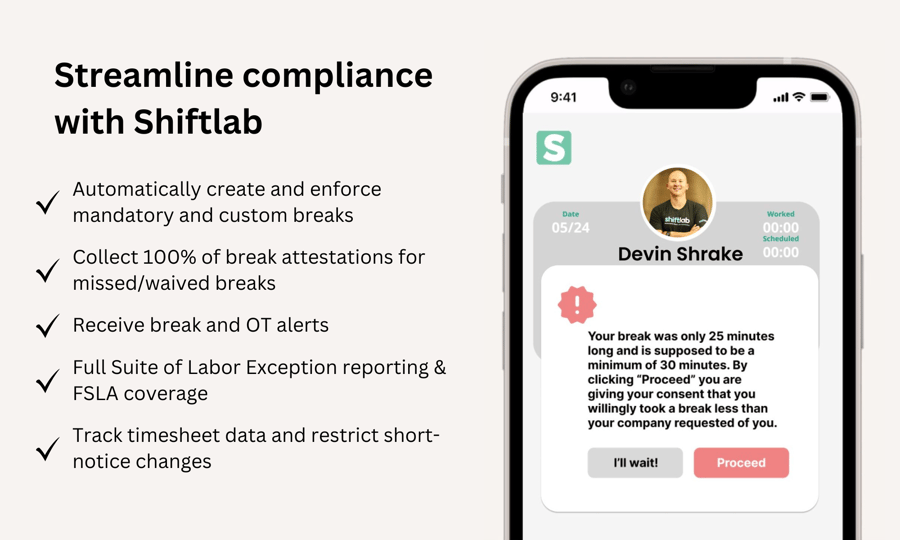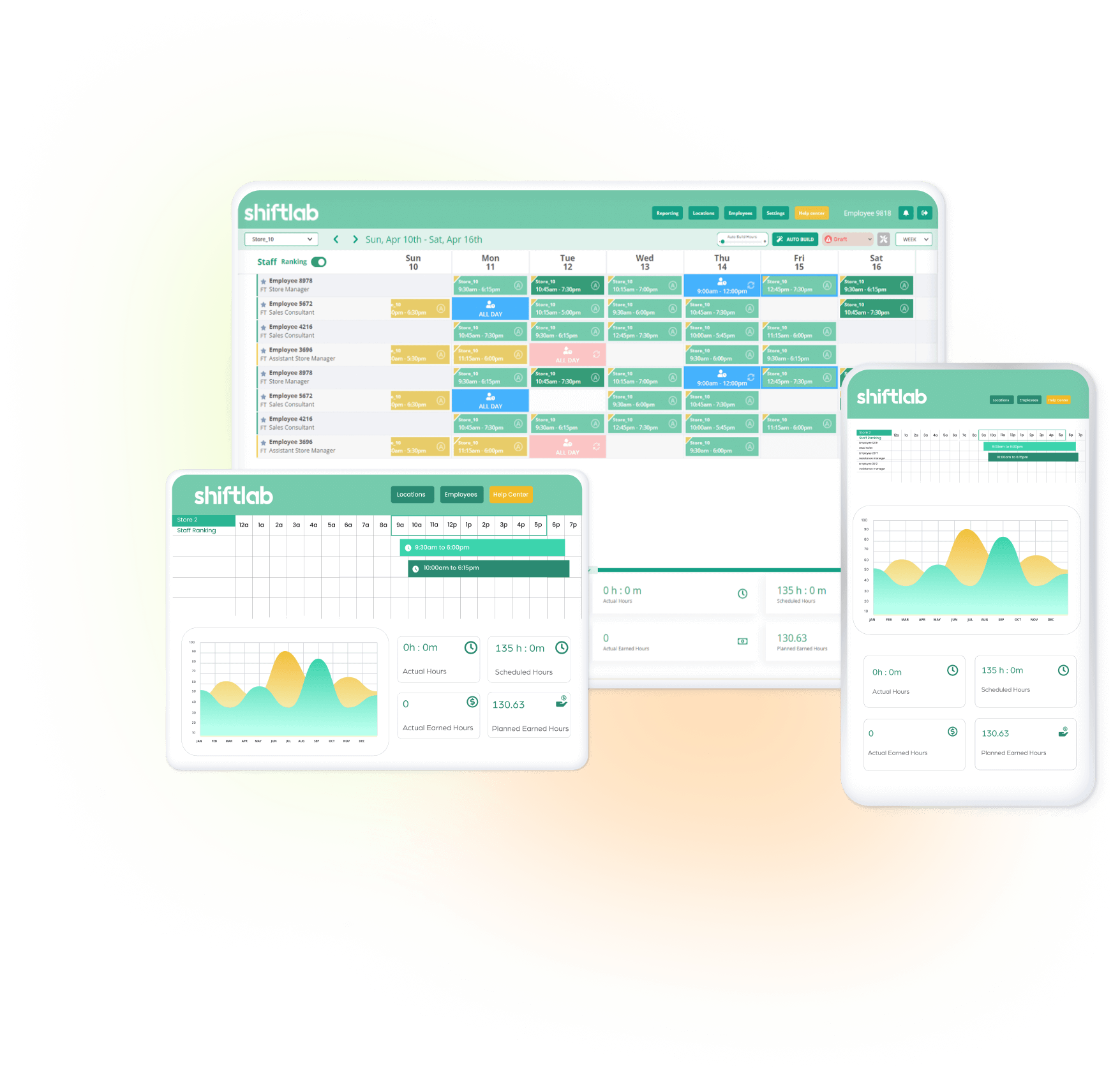
Retail Scheduling
Strategies and Best Practices for Retail Employee Scheduling

There’s a lot that goes into running a retail store. Hiring and coaching, ensuring excellent customer service, lowering turnover, managing inventory and creating employee schedules, to name just a few.
Creating retail employee schedules, in particular, can be a complex and time-consuming task. Retail managers need to create a schedule that satisfies all employees while meeting the needs of the store.
Scheduling employees for optimum productivity requires a strategic approach. You need to be able to predict traffic, demand and match this with the right people in the right place at the right time.
In this guide, we’ll cover:
- What is Retail Scheduling?
- How to Make a Retail Employee Schedule
- Benefits of Retail Employee Scheduling Optimization
- Common Scheduling Mistakes to Avoid
What is Retail Scheduling?
Retail scheduling is creating weekly schedules that assign shifts to employees working at a retail store. Typically, the district manager or store manager is responsible for this task.
Effective retail scheduling is a very critical task in retail operations. Not only because it is essential for operating the store efficiently, but also because it significantly affects the lives of all the employees working there.
There are so many factors that go into creating a retail schedule:
- Store size
- Average sales volume
- Number of employees available
- Peak sales periods
- Managing full-time and part-time employees
- Managing floating employees
- Sticking to a budget
- Creating shifts around your top workers
- Handling changes, time off, overtime, etc.
All of this affects the store’s payroll budget and the hours needed to cover.

How to Make a Retail Employee Schedule
Crafting an effective retail employee schedule goes beyond simply evaluating when your staff is available. Managers need a scheduling strategy that factors in employee preferences, retail business needs, demand trends, regulations, and more to create a strategic schedule that ensures your store will run smoothly. From boosting your bottom line to enhancing customer experience and reducing employee turnover rates, a well-planned schedule is the unsung hero of a thriving retail operation.
Here are the 10 best practice steps we recommend for creating an effective retail employee schedule:
-
Optimize Scheduled Hours
Schedules that leave a store understaffed create a negative guest experience and overwhelmed employees while overstaffing can be disastrous to the bottom line.
All retailers are faced with the delicate balance of delivering outstanding client service while striving to reduce workforce expenses, both in high-demand periods and in the intervals between them.
Predicting customer demand shouldn’t be left to chance or a manager’s gut instinct. Choose a retail scheduling solution that has AI-Driven forecasting built in. Forecasts should be created using historical sales data, recent trends and event effects (like weather) to accurately predict demand for each location.
-
Factor in Employee Performance
In retail, having your best sales associates on the floor during peak hours is crucial to maximizing sales and profit.
Performance-based scheduling draws on the sales and operational strengths of your front-line employees. It gives managers the tools to ensure their teams are scheduled at the right place and right time to drive optimum performance and allows them to make calculated scheduling decisions based on real-time business trends.
Instead of scheduling to preferences, or treating the scheduling process like an operational task, performance-based scheduling enables your team to think strategically about how they position their team for success in the weeks ahead.
To implement performance-based scheduling, look for a retail employee scheduling software that connects to your POS to identify top performers and place them in prime shifts. Shiftlab's customers using performance-based schedules see an increase in profitability per employee of up to 6% and an increase in guest satisfaction scores of up to 13%.
-
Integrate Scheduling and Time Keeping
It is imperative to monitor employee working hours for accurate attendance tracking, efficient HR management, and accurate payroll processing.
Various methods are available for this purpose, but employing a comprehensive scheduling software for retail, equipped with an integrated mobile time clock application, proves to be the most effective approach.
This all-in-one solution saves significant time for managers. For instance, managers can:
- See if a store is late to open
- See if an employee has not shown up for their shift
- Monitor breaktimes
- Easily spot missing time entries and reconcile auto clock-outs
- Easily check scheduled shifts vs actual worked hours
-
Create schedules that respect your employees’ preferences and availability
With turnover in the retail sector being higher than ever, it’s crucial to respect your employee’s scheduling preferences and help them maintain a healthy work-life balance.
Studies indicate that granting employees some level of autonomy over their work schedules boosts their engagement and job contentment, without imposing any additional responsibilities on their managers.
Employee Scheduling software can help you track employee availability and ensure that all schedules created are factoring in employee preferences and availability.
-
Make it Easy for Employees to Access Schedules
Say goodbye to those last-minute phone calls or texts: the introduction of a mobile app gives employees the power to conveniently access their schedule whenever they need. It allows them to check their start times and work locations, all at their fingertips through their smartphones.
Publish schedules in advance to help your staff plan ahead for things like transportation and childcare.
Look for a mobile scheduling app that enables you to:
- Create, edit, and share schedules
- Send reminders to employees before each shift
- Make it easy for retail staff to clock in and out
- Collect break attestations
-
Be proactive and communicative
Effective communication is the backbone of successful scheduling. Set clear expectations from the beginning and establish written policies for time-off requests. Publish schedules in advance to help your employees plan ahead for things like transportation and childcare. You should also encourage open communication within your team and make it easy for staff to request changes.
This is where providing employees with a mobile app for their schedule can come in handy: it empowers them to easily see their schedule at any time, including when they’re starting and at what location, all from their phone.
-
Have a back-up plan in place
Everyone in the retail world knows that it’s unpredictable — so it’s important to have a contingency plan. Keep a standby pool of employees who are willing to take extra shifts, employ floating employees who can jump in at different stores as needed, and have a set plan for hiring more staff if the need arises so you can hire quickly.
It’s especially important to have a back-up plan during busy seasons like the holidays. Check out our holiday scheduling guide for more tips and scheduling best practices.
-
Follow rules and regulations to stay compliant
Adhering to federal, state, and local labor laws is non-negotiable. Ensure compliance with rules regarding required breaks, overtime scheduling and pay, holidays, and more.
Also, make sure you’re aware of any predictive scheduling laws that apply to your location to avoid legal issues. These regulations set requirements for notifying employees about their schedules within a specific timeframe.
Shiftlab’s scheduling platform includes built-in compliance tools to help you avoid costly fees and have peace of mind when it comes to staying compliant.

-
Use the right tools to simplify employee scheduling
While spreadsheets have been the traditional go-to for scheduling, investing in modern tools can significantly streamline the process. These tools provide real-time visibility into schedules and changes, making it easier for both managers and staff to navigate and collaborate efficiently.
Retail scheduling tools that are powered by AI also help streamline the scheduling process by taking into account multiple data points (store traffic and sales, employee performance, budgeted hours, time off, and more) to automatically create better schedules.
In just a fraction of the time you currently spend on planning employee schedules, retail scheduling software allows you to:
- Create and manage schedules for multiple locations
- Optimize labor costs
- Ensure that schedules are compliant
- Track employees’ time
- Prevent payroll-related error
Retail scheduling software can help you take scheduling from a task to a strategy. It’s a game changer in eliminating the guesswork that goes into effective scheduling.

Shiftlab integrates scheduling and time keeping so managers can stay up-to-date on their stores and staff in real-time. -
Lean on Automation
In the retail industry, where profit margins are often slim, the importance of enhancing processes such as staff planning cannot be overstated.
Creating strategic schedules, monitoring hours worked, reducing expenses, handling staff requests, approving leave, and efficiently communicating with your team can be significantly automated and simplified through a comprehensive retail scheduling software solution.
An automated scheduling solution can centralize strategic and tactical staffing needs into one solution. These technologies enable managers to develop schedules in advance, determine employee availability, allow adequate rest time between shifts, and maintain all of the operational rules needed to keep operations compliant.
.png?width=900&height=504&name=Automation%20Detail%20(1).png)
Benefits of Retail Employee Scheduling Optimization
Intense competition combined with a labor shortage, means that retailers have no choice but to optimize all aspects of operations. Staffing is no exception.
Employee scheduling needs to go beyond simply meeting current staffing needs. It has to directly support business growth. Optimizing retail employee scheduling will allow you to control labor costs, increase profitability and improve productivity.
The benefits of optimizing your retail schedule include:
-
Lower Labor Costs
Overstaffing or understaffing leads to lost money. That means you could lose out on money back into the business because of potentially bad customer service or paying employees for idle time. Scheduling optimization helps you understand where and when you need to have employees and how many employees need to be scheduled.
Scheduling optimization also looks at things like strategic break placement. Break percentages and placement can make a huge difference to your bottom line.
Here's why:
- The difference between 0% breaks and 100% breaks is over 6% of your labor
- Breaks strip costs from overtime hours first, not regular hours (this bumped that 6% up to 10%)
- When they don't take breaks, employees leave earlier (often during high-converting times)
- When you actually schedule breaks, people take them twice as often – it's that simple.
Labor is your largest cost. Being strategic about the seemingly small things like breaks can lead to higher profitability.
-
Improved Customer & Employee Experience
Scheduling optimization enables retailers to ensure they have the right number of staff at the right times to ensure a positive guest experience in their stores. Retailers can go one step further in ensuring an exceptional guest experience by place top-performing employees in prime shifts.
Scheduling optimization also creates a better experience for employees by preventing over or understaffing situations and ensuring that schedules reflect employee preferences and availability.
-
Remaining Compliant with State and Federal Rules
Paid or unpaid breaks, payroll, and taxes can be a headache to manage and fines for non-compliance are expensive. State rules vary, and federal rules may change, so it’s important to stay up-to-date on anything that can impact how you pay employees at your business or the records you need to keep.
Scheduling optimization helps you streamline this part of your business, from employee hours worked to the amount they need to be paid for it.
Common Scheduling Mistakes to Avoid
Before creating your retail staff schedules, let’s get some common pitfalls out of the way so you can easily avoid them.
Ignoring business needs: It's great to accommodate employee preferences, but don't forget about the bigger picture. Factor in-store demand, seasonal trends, and other external factors to ensure your schedule aligns with your business goals.
Last-minute scheduling: Give your team ample notice. Not scheduling far enough in advance can lead to disgruntled employees and operational hiccups.
Lack of a backup plan: Life happens, and employees may call in sick or have unexpected conflicts. Always have a backup or hiring plan ready to fill gaps in your schedule without causing chaos.
Communication breakdown: Proactive communication is key. Keep your team informed about schedules, changes, and expectations. Encourage them to communicate their availability and concerns too, fostering a collaborative atmosphere.
Outdated tools: Don't get bogged down with manual scheduling. Invest in the right scheduling tools to streamline the process, save time, and reduce errors. Modern technology and automated scheduling platforms (like Shiftlab) can be a game-changer!
By avoiding these scheduling mistakes, you'll be well on your way to creating a more efficient and strategic retail schedule.
Conclusion
When it comes to managing a retail team, scheduling is one of the most critical factors in driving success. It's all about finding the perfect balance between flexibility and accountability while taking into account employee preferences and availability.
Whether you are a new manager or simply looking to optimize your scheduling process, Shiftlab can help. Our retail scheduling platform, used by over 30,000 employees in 6,000+ retail locations, takes a unique performance-based approach to help you boost profits while ensuring compliance and employee satisfaction.
Book a free demo with us today to learn more!
Related Blogs


How to Measure Retail Store Performance with Retail KPIs
In the retail industry, measuring store performance is crucial for sustained success. Retail...

7 Strategies to Reduce Overtime Costs for Your Retail Business
Retailers often face the challenge of balancing staffing needs with financial efficiency, and one...
Flexible Retail Platform
Shiftlab seamlessly integrates your POS, Traffic, and Time Clock data into a single system.
Explore Integrations

Your complete retail performance platform
- Automated Scheduling
- Ai-Driven Forecasting
- Smart Timeclock
- Real-Time Performance Data
%201.png?width=564&height=119&name=Shiftlab_Logo%20(Black)%201.png)